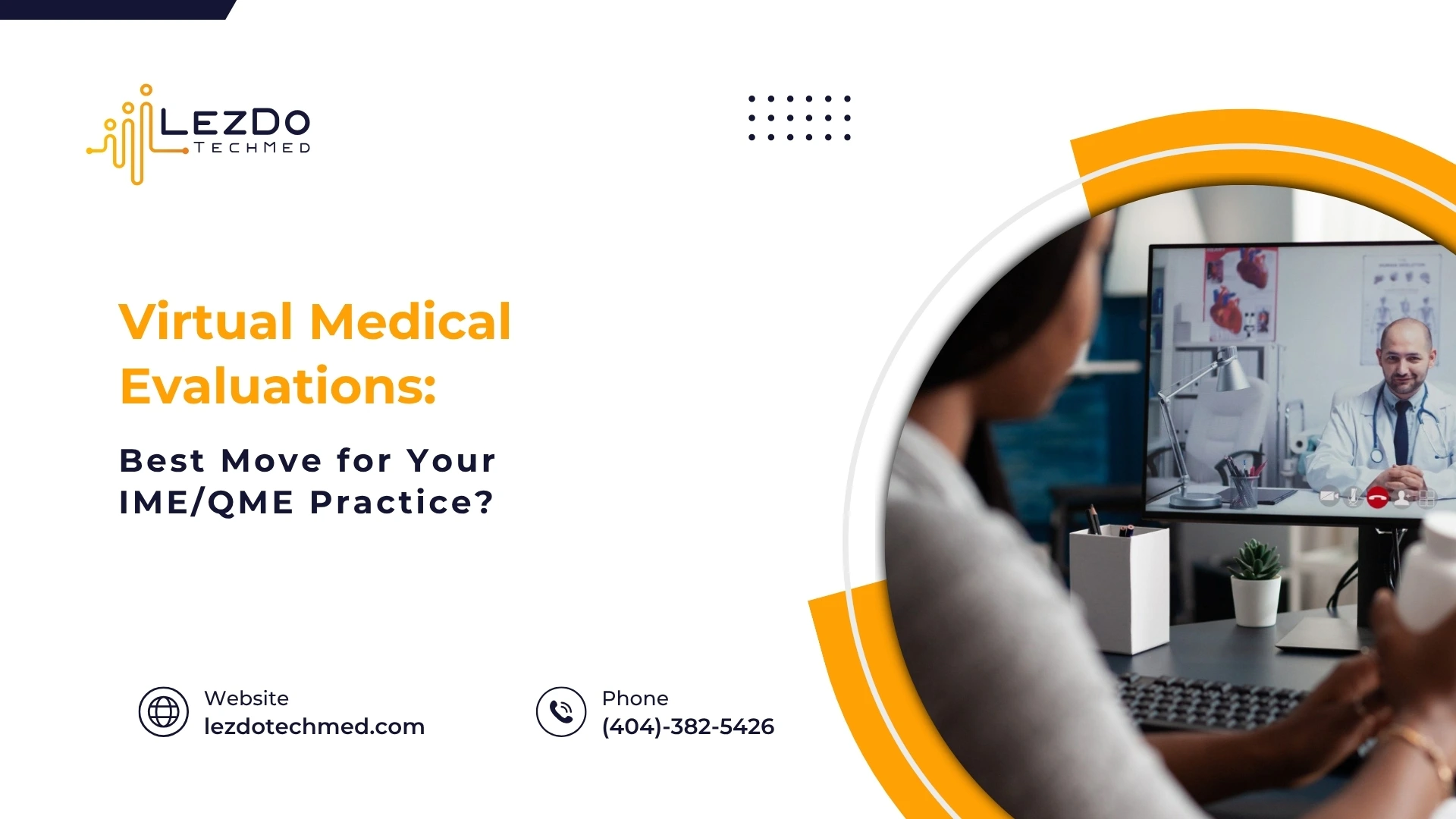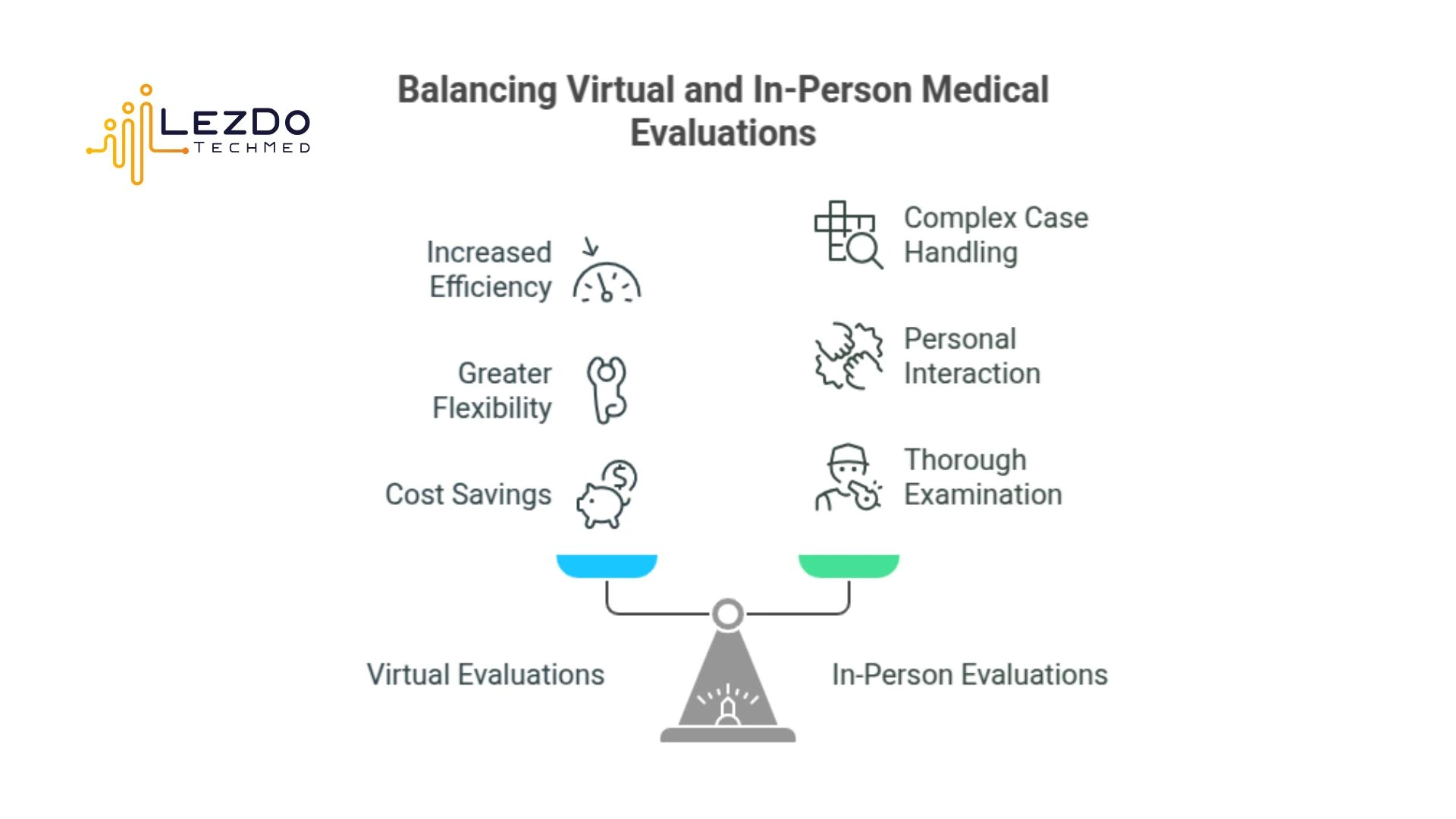As an Independent Medical Examiner (IME) or Qualified Medical Evaluator (QME), you may have noticed a growing trend, that is virtual medical evaluations.
During the COVID pandemic, virtual evaluations became a convenient solution for medical evaluators. However, now it has become a regular part of the evaluation process. Many evaluators have already started digitizing part of their work. But is this shift right for your practice?
Let’s dive deeper into the specifics of virtual medical evaluations and whether they suit your practices.
What are Virtual Medical Evaluations?
Virtual medical evaluations (tele-evaluations or remote exams) are exams conducted through video calls or other secure online platforms. You meet the examinee online rather than in person. You still ask questions, review medical history, and assess symptoms, but it is all done remotely.
Some IMEs and QMEs use virtual medical evaluations as a part of their processes, such as intake or follow-up, while others conduct full exams online when needed.
Why are virtual medical evaluations gaining popularity?
Virtual evaluations offer many benefits. Let’s see the reasons why more evaluators prefer to go virtual:
Save time:
You don’t have to travel to a location or wait for examinees who might show up late. You can conduct examinations or evaluations in a day and spend more time reviewing records or preparing reports.
Reach more people:
When you are not limited by geography, you can take cases from across the cities or even other parts of the state without traveling distances.
Reduce exam cancellations:
Virtual exams are more convenient for patients. They don’t have to arrange transportation, take time off work, or travel distances. This especially helps people with severe injuries or disabilities. When you offer virtual evaluations, there are fewer cancellations and no-shows from the examinees’ side.
Cut down expenses:
You do not need much office space or support staff for doing virtual evaluations. This can lower your business expenses over time.
What type of cases can go virtual?
Virtual evaluations work well for certain types of cases, such as:
- Mental health or psychiatric assessments
- Follow-up evaluations
- Medical history reviews
- Evaluations where observation and conversation are vital
Don’t think that all exams can be done virtually. For example, if you need to do hands-on testing, strength measurements, or a physical touch exam, in-person evaluations may still be better.
Is virtual evaluation suitable for your practice?
How to find out if a virtual medical evaluation is suitable for you? Ask these questions:
- What kind of evaluations do you do?
If your evaluations include only interviews, medical record reviews, and observation, then virtual exams could work well for you. However, if your evaluations depend on physical tests or procedures, going fully virtual may not suit your practice.
- Do you have the necessary technology?
To do virtual exams, you’ll need:
- A reliable internet connection
- A good webcam and microphone
- A secure video platform (HIPAA-compliant)
- A private, quiet space with no kinds of interruptions
- A system for sharing documents and getting signatures
If you’re missing any of the above, you may need to invest a significant amount to get the set up. However, once you’ve done that, it can save you time and money in the long run.
- Are you comfortable with using technology for IME/QME processes?
If you’re not a digitally skilled person, the idea of virtual exams might sound overwhelming. Don’t worry! Most of these platforms are user-friendly. With a little practice, you can learn quickly. Many IMEs and QMEs have noted that they felt more confident after doing a few virtual evaluations.
Are there any legal and compliance issues in virtual evaluations?
Before you switch to virtual evaluations, make sure you understand the legal side. Different states have different rules about telehealth and remote evaluations, especially in worker’s comp and personal injury cases.
How to ensure compliance?
Ask these questions yourself:
- State guidelines: Are virtual IMEs/QMEs allowed in your state?
- Report requirements: Are there any extra steps needed to document a virtual exam?
- Consent: Do you need written consent from the patient or the attorney to do it virtually?
- Platform security: Is your video platform secure and HIPAA compliant?
If you’re not sure, talk to a legal advisor. It’s important to stay compliant to protect your license and reputation.
How to Start with Virtual Evaluations
You don’t need to jump into virtual evaluations all of a sudden. Let’s see how to move ahead step-by-step:
- Start with specific cases
Start offering virtual evaluations for cases that don’t require physical examinations, like psychiatric evaluations, record reviews, and follow-up visits.
- Offer hybrid options for examinees
Let your clients choose between in-person or virtual, whichever they are comfortable with. This gives them flexibility and lets them transition into virtual evaluation slowly.
- Practice evaluations with your staff or colleagues
Before going into virtual evaluations, do a few trial runs with your coworkers or friends. Ensure that your video, lighting, and sound work well during the session.
- Create a checklist for virtual exams
Before every evaluation make sure you have the following ready:
- All medical records
- Patient’s consent for virtual evaluations
- A calm, distraction-free environment
- Backup contact info in case of any tech issues
Having a proper setup can ensure the evaluation goes smoothly and professionally.
Will virtual evaluations replace in-person exams?
Not completely. There will always be cases that require in-person evaluations. However, virtual evaluations can help you work more efficiently and offer more options to clients.
Many IMEs and QMEs are choosing to combine both approaches, using in-person for complex cases and virtual for simpler ones. This hybrid model gives you the best of both.
Briefly put,
Virtual evaluations are going to be the present and future of medical evaluations. They offer more flexibility, reduce your workload, and help you reach more clients. Moreover, they also save your time and money.
However, they may not fit for all cases. You must consider:
- What kind of evaluations you do
- Your comfort with technology
- Legal and state compliance rules
- Your workflow and client needs
If you’re interested, give it a try and see it yourself. You might be surprised at how well it works.
The future of IME and QME businesses is becoming more digital. Will your firm be part of it?
Want to get more insights to grow your practice?










